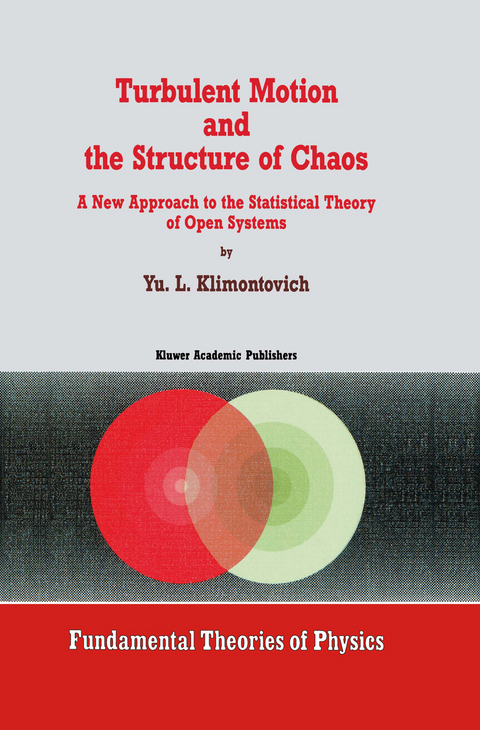
Turbulent Motion and the Structure of Chaos
Springer (Verlag)
978-0-7923-1114-0 (ISBN)
I.1. The Criteria of the Relative Degree of Order of the States of Open Systems.- I.2. Connection Between the Statistical and the Dynamic Descriptions of Motions in Macroscopic Open Systems. The Constructive Role of Dynamic Instability of Motion.- I.3. The Transition from Reversible to Irreversible Equations. The Gibbs Ensemble in the Statistical Theory of Nonequilibrium Processes.- I.4. The Role of Fluctuations at Different Levels of Description. Fluctuation Dissipation Relations.- I.5. Brownian Motion in Open Systems. Molecular and Turbulent Sources of Fluctuations.- I.6. Laminar and Turbulent Motion.- 1. Evolution of Entropy and Entropy Production in Open Systems.- 1.1. Chaos and Order. The Controlling Parameters. Physical Chaos. Evolution and Self-Organization in Open systems.- 1.2. Boltzmann-Shannon-Gibbs Entropy.- 1.3. Entropy Distribution Function.- 1.4. The Gibbs Ensemble. Smoothing over the Physically Infinitesimal Volume. Entropy Including Fluctuations. Space (Time) and Phase Averages. Local Ergodicity Condition.- 1.5. The Kinetic Boltzmann Equation for Statistical and Smoothed Distribuions. Physically Infinitesimal Scales. The Constructive Role of the Dynamic Instability of Motion of Atoms in a Gas.- 1.6. The Role of Nonequilibrium Fluctuations in a Boltzmann Gas. Molecular and Turbulent Sources of Fluctuations.- 1.7. The Kinetic Equations for the N-Particle Distribution Functions. The Leontovich Equation.- 1.8. Boltzmann’s H-Theorem for Smoothed (Pulsating) and Deterministic Distributions.- 1.9. Entropy and Entropy Production for Smoothed and Deterministic Distributions.- 1.10. The Gibbs’ Theorem.- 1.11. H-Theorem for Open Systems. Kulback Entropy.- 1.12. Evolution in the Space of Controlling Parameters. The S-Theorem.- 1.13. The S-Theorem. LocalFormulation.- 1.14. The Comparison of the Relative Degree of Order of States on the Basis of the S-Theorem Using Experimental Data.- 1.15. Dynamic and Statistical Descriptions of Complex Motions. K-Entropy, Lyapunov Indices. Nonlinear Characteristics of the Trajectory Divergence.- 1.16. Criteria of Dynamic Instability of Motion in Statistical Theory.- 1.17. Entropy as Measure of Diversity in Biological Evolution.- 1.18. The Principle of Minimum Entropy Production in Self-Organization Processes.- 2. Transition From the Reversible Equations of Mechanics to the Irreversible Equations of the Statistical Theory.- 2.1. Two Types of Reversible Processes. Symmetry Properties of Distribution Functions.- 2.2. Liouville Equation and Vlasov Equation. The First Moments and the “Collisionless” Approximations.- 2.3. Reversible Equations in Quantum Statistical Theory.- 2.4. Two Types of Dissipative Kinetic Equations for N-Particle Distributions.- 2.5. Measure of Deficiency (Incompleteness) of the Statistical Description.- 2.6. The Hierarchy of Equations of Fluid Mechanics.- 3. Fluctuation Dissipation Relations.- 3.1. Examples of Fluctuation Dissipation Relations.- 3.2. FDR for N-Particle Distribution Functions.- 3.3. Thermodynamic Form of the FDR. The Callen-Welton Formula.- 3.4. FDR for a Boltzmann gas. The Fluctuative Representation of Boltzmann Collision Integral.- 3.5. FDR for Large-Scale (Kinetic) Fluctuations.- 3.6. Examples of FDR for Large-Scale Fluctuations.- 3.7. System of Quantum Atoms Oscillators.- 3.8. Fluctuation Dissipation Relations in Hydrodynamics.- 3.9. Two Ways of Defining Kinetic Coefficients.- 3.10. The Molecular Langevin Source in the Difffusion Equation.- 3.11. Connection between the Intensities of Langevin Sources and the Correlator of of Phase DensityFluctuations.- 3.12. Natural Flicker Noise (“1/f Noise”). FDR for Flicker Noise.- 3.13. Natural Flicker Noise and Superconductivity.- 4. Brownian Motion.- 4.1. Fokker-Planck and Langevin Equations.- 4.2. Three Definitions of the Langevin and Fokker-Planck Equations.- 4.3. The Fokker-Planck Equations in the Statistical Theory of Nonequilibrium Processes.- 4.4. Transition to the Fokker-Planck Equation from the Smoluchowski equation (the Chapman-Kolmogorov Equation) and from the Master Equation.- 4.5. Langevin.Sources in Kinetic Equations.- 4.6. Langevin Sources in Fokker-Planck and Einstein-Smoluchowski Equations.- 4.7. Turbulent Langevin Sources and Fluctuation Dissipation Relations in Hydrodynamics.- 4.8. Brownian Motion in Systems with a Variable Number of Particles..- 5. The Boltzmann-Gibbs-Shannon Entropy As Measure of the Relative Degree of Order in Open Systems.- 5.1. Van der Pol Generator.- 5.2. Generator with Inertial Nonlinearity.- 5.3. Invariant Measures. Examples of Gibbs Distributions for Open Systems.- 5.4. Generalized Van Der Pol Generators. Bifurcations of the Limiting Cycle Energy and the Period of Oscillations.- 5.5. Dynamic and Statistical Distributions.- 5.6. Comparison Between the Degrees of Order in the Bifurcation Points and in the State of Dynamic Chaos.- 5.7. Evolution of Entropy in Systems with Two Controlling Parameters.- 5.8. A Medium of Linked Generators. The Kinetic Approach in the Theory of Self-Organization.- 5.9. A System of Van der Pol Generators with Common Feedback. Associative Memory and Pattern Recognition.- 5.10. Kinetic Description of Chemically Reacting Systems.- 5.11. A Medium of Bistable Elements. The Kinetic Approach in the Theory of Phase Transitions.- 6. Turbulent Motion. The Structure of Chaos.- 6.1. CharacteristicFeatures of Turbulent Motion. The Main Problems.- 6.2. Incompressible Fluid. Reynolds Equations. Reynolds Stresses.- 6.3. Well-Developed Turbulence. Turbulent Viscosity.- 6.4. Semiempirical Prandtl-Karman Theory of Turbulence.- 6.5. Onset of Turbulence in Steady Couette and Poiseuille Flows.- 6.6. Entropy Production in Laminar and Turbulent Flows.- 6.7. The Principle of Least Dissipation and the Principle of Minimum Entropy Production in Self-Organization Processes.- 6.8. Evolution of Entropy in the Transition from Laminar to Turbulent Flow.- 6.9. Kinetic Description of Hydrodynamic Motion.- Conclusion.- References.
| Erscheint lt. Verlag | 30.9.1991 |
|---|---|
| Reihe/Serie | Fundamental Theories of Physics ; 42 |
| Zusatzinfo | XI, 401 p. |
| Verlagsort | Dordrecht |
| Sprache | englisch |
| Maße | 155 x 235 mm |
| Themenwelt | Mathematik / Informatik ► Informatik ► Theorie / Studium |
| Naturwissenschaften ► Physik / Astronomie ► Astronomie / Astrophysik | |
| Naturwissenschaften ► Physik / Astronomie ► Atom- / Kern- / Molekularphysik | |
| Naturwissenschaften ► Physik / Astronomie ► Theoretische Physik | |
| Naturwissenschaften ► Physik / Astronomie ► Thermodynamik | |
| ISBN-10 | 0-7923-1114-0 / 0792311140 |
| ISBN-13 | 978-0-7923-1114-0 / 9780792311140 |
| Zustand | Neuware |
| Haben Sie eine Frage zum Produkt? |
aus dem Bereich


